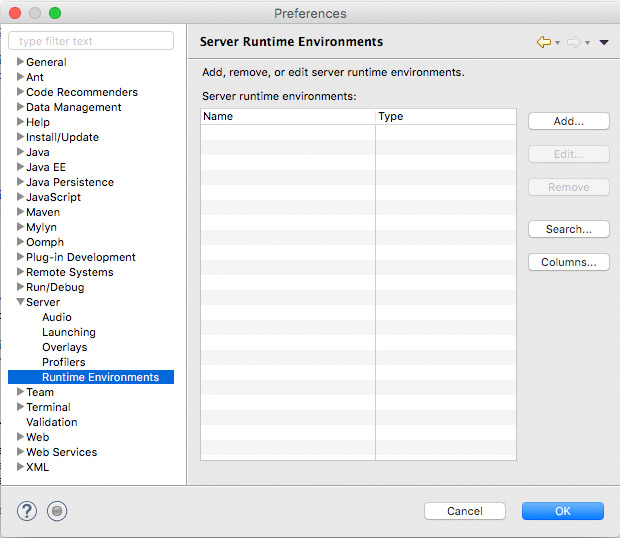Tomcat For Mac
Posted : admin On 9/27/2019To get Tomcat, visit the following link: http://tomcat.apache.org/. Once there, click on one of the Tomcat versions such as version 8 or version 9. Under Core, select the tar.gz file.
Download the tar.gz file. macOS / Mac OS X will probably extract the file to a .tar file in your downloads directory. Move this .tar file to a location on your computer where you would like tomcat. For purposes of this guide, the location will be /Users/user. Double-click the tar to extract it. This should create a directory in /Users/user named something like apache-tomcat . . . Rename this to something simple like tomcat. At this point, you should have the following directory on your machine:
/Users/user/tomcat
There is a file called startup.sh located in the the /Users/user/tomcat/bin directory that needs edited. Open EditRocket and open startup.sh Add the following two lines after the line in startup.sh that starts with EXECUATBLE. Note that for Snow Leopard, you can use 1.6 instead of 1.5 after the Versions text in the first line listed below.
export JAVA_HOME=/System/Library/Frameworks/JavaVM.framework/Versions/1.5/Home
export CATALINA_HOME=/Users/user/tomcat

Tomcat For Mac Free Download
Apache tomcat free download - BitNami Tomcat Stack, Apache, Apache OpenOffice, and many more programs. Feb 17, 2019 In this tutorial I show you how to install Apache Tomcat, Java, and Eclipse on Windows and MacOS. MacOS users skip to 6:49. Along with that we'll run a Java Server Page and Servlet. This article is for a developer who has just started using Mac. As with every new Mac user, it took me some time to figure out how to get Apache Tomcat for Java installed on my MacBook. To ease this process for my readers, this article summarises this process to make it easy for you to install Tomcat on your machine. Installing JDK. Oct 03, 2017 Tomcat is the servlet container that is used in the official Reference Implementation for the Java Servlet and JavaServer Pages technologies. The Java Servlet and JavaServer Pages specifications are developed by Sun under the Java Community Process. Tomcat is developed in an open and participatory environment and released under the Apache Software License. This is for installing tomcat as a daemon on port 8080 but enable also port 80 by using a firewall redirection. It was tested on Mac OS 10.6 but should work also with 10.5.
Installing Tomcat For Mac
To start Tomcat, open up a Terminal window (Applications -> Utilities -> Terminal). cd to the tomcat bin directory by typing the following:
cd /Users/user/tomcat/bin
Type the following:
sh startup.sh
This will start Tomcat. To shutdown tomcat, type sh shutdown.sh
To test the tomcat installation, enter the following in your web browser:
http://localhost:8080/
If the apache tomcat page shows up, the installation was successful.
Tomcat For Macbook

New os for mac. There is a sample web application called jsp-examples located in the webapps directory under the tomcat installation directory. This location can be used to test your own JSP pages, or you can use the files contained in this directory as a template for creating your own web application.
The jsp-examples can be accessed in your web browser using the following URL: http://localhost:8080/jsp-examples/
Apache Tomcat can be started and stopped from the command line.
To learn how to start and stop Apache Tomcat from the command line in a Windows environment, follow these five steps:
Download Tomcat For Mac
- Start a Command Prompt from the Start menu.
- Navigate to the Tomcat
bindirectory, e.g.,c:/Tomcat8/bin: - Type in
startupand then hit Enter to execute the Tomcat server start up script: - A separate window will open and a series of messages will appear, followed by the message indicating the server is started:
The exact number of milliseconds will vary based on the number of web applications that are deployed, among other factors. - To stop the Tomcat server, type in
shutdownand then hit Enter in the original command prompt:
The startup window that appeared earlier will now be closed, indicating the Tomcat server has been stopped.